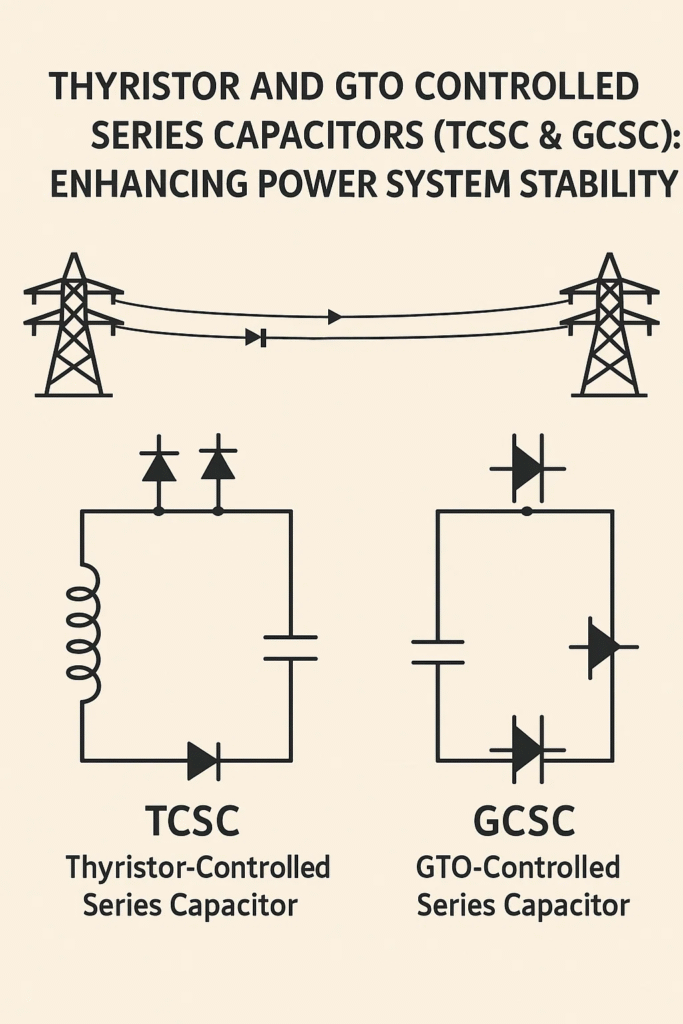Introduction
As global electricity request surges and renewable energy sources develop more predominant, the stability and efficiency of power transmission systems are under growing pressure. Traditional grid substructure often struggles to keep up with dynamic load changes, voltage variations, and power oscillations. To address these challenges, engineers have developed advanced technologies known as Flexible AC Transmission Systems (FACTS).
Among the most impactful FACTS devices are the Thyristor-Controlled Series Capacitor (TCSC) and the Gate Turn-Off Thyristor Controlled Series Capacitor (GCSC). These devices offer lively control over transmission line impedance, allowing real-time optimization of power flow and significantly ornamental system stability.
Understanding Controlled Series Compensation
Controlled Series Recompense (CSC) involves inserting capacitive reactance into transmission lines to reduce their overall impedance. This technique improves power transfer capability, voltage stability, and system reliability.
Why Series Compensation Matters
The power transfer across a transmission line is governed by:
P = \frac{V_1 V_2}{X} \sin(\delta)
Where:
– V_1, V_2 are sending and receiving voltages,
– X is the line reactance,
– \delta is the power angle.
Reducing X increases P, allowing more power to flow through the line. CSC devices like TCSC and GCSC dynamically adjust this reactance, making them crucial for modern grids.
What Is a Thyristor-Controlled Series Capacitor (TCSC)?
Overview:
A TCSC is a FACTS device that expands transmission efficiency by dynamically controlling line impedance through thyristor switching. It consists of:
– A Fixed Capacitor (FC) – stores reactive power.
– A Thyristor-Controlled Reactor (TCR) – adjusts the reactance.
– Control Electronics – manages thyristor firing angles.
Working Principle:
By controlling the thyristor firing angle \alpha, the inductive reactance X_L(\alpha) of the TCR changes. The net impedance becomes:
X_{TCSC} = X_C + X_L(\alpha)
Where:
– X_C is the fixed capacitor reactance,
– X_L(\alpha) is the variable inductive reactance.
This dynamic control allows the TCSC to control power flow, damp oscillations, and stabilize voltage.
What Is a Gate Turn-Off Thyristor Controlled Series Capacitor (GCSC)?
Overview:
The GCSC is a newer FACTS device that uses Gate Turn-Off Thyristors (GTOs) instead of conservative thyristors. This enables:
– Faster switching,
– Lower losses,
– More precise control.
Working Principle:
GCSC modulates the series capacitance by turning GTO thyristors on and off. It can operate in:
– Voltage Compensating Mode – maintains rated voltage across a range of currents.
– Reactance Compensating Mode – preserves maximum reactance regardless of current.
This flexibility makes GCSC ideal for high-speed, high-efficiency applications.
Modes of Operation:
TCSC Modes
– Blocked Mode: Thyristors are off; behaves like a fixed capacitor.
– Bypass Mode: Thyristors fully conduct; capacitor is bypassed.
– Partially Conducting Mode: Thyristors conduct partially; dynamic impedance control.
GCSC Modes:
– Voltage Mode: Maintains constant voltage across the capacitor.
– Reactance Mode: Maintains constant reactance regardless of current.
TCSC vs GCSC: Key Differences
| Feature | TCSC | GCSC |
| Switching Device | Thyristor | Gate Turn-Off Thyristor (GTO) |
| Control Method | Firing Angle | Gate Signal |
| Response Time | Moderate | Fast |
| Harmonics | Higher | Lower |
| Efficiency | Good | Better |
| Complexity | Moderate | High |

Enhancing Power System Stability
Both TCSC and GCSC donate significantly to power system stability:
1. Increased Power Transfer Capability
– Reduces line reactance.
– Allows more power to flow through existing infrastructure.
2. Improved Voltage Stability
– Provides dynamic reactive power support.
– Prevents voltage collapse during peak loads.
3. Damping of Power Oscillations
– TCSC stabilizes fleeting disturbances.
– GCSC offers faster checking response.
4. Mitigation of Sub-Synchronous Resonance (SSR)
– Prevents harmful interactions between generator chutes and transmission lines.
– Reduces mechanical stress and equipment wear.
5. Reduction of Transmission Losses
– Optimizes impedance.
– Minimizes resistive losses.
Real-World Applications:
1. High-Voltage Transmission Networks
– Enhances grid reliability.
– Supports long-distance power transfer.
2. Renewable Energy Integration
– Manages variability in wind and solar output.
– Stabilizes grid during fluctuations.
3. Congested Power Networks
– Increases broadcast capacity without new lines.
– Eases bottlenecks.
4. Industrial Power Systems
– Reduces voltage sags.
– Supports heavy industrial loads.
Challenges and Limitations:
Despite their benefits, TCSC and GCSC face some challenges:
– High Installation Costs: Advanced modules and control systems.
– Harmonics and EMI: Especially in TCSC, requiring filtering.
– Complex Control Strategies: Real-time control in large grids is demanding.
Future Trends:
The future of TCSC and GCSC is promising:
– AI-Based Predictive Control: Smarter, adaptive compensation.
– Advanced Semiconductors: Faster, more efficient switching.
– Hybrid FACTS Systems: Combining TCSC/GCSC with STATCOM or SVC.
Conclusion:
Thyristor-Controlled Series Capacitors (TCSC) and Gate Turn-Off Thyristor Controlled Series Capacitors (GCSC) are revolutionizing power transmission. By offering dynamic control over line impedance, they improve stability, optimize power flow, and support the integration of renewables.
As power systems grow toward smart grids and high-efficiency networks, TCSC and GCSC will play a pivotal role in ensuring reliable, resilient, and maintainable electricity delivery.
